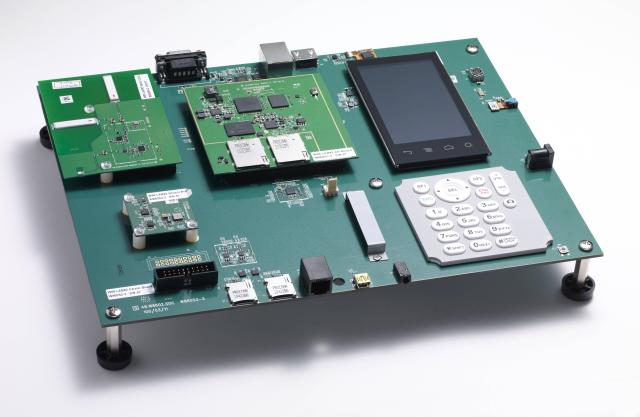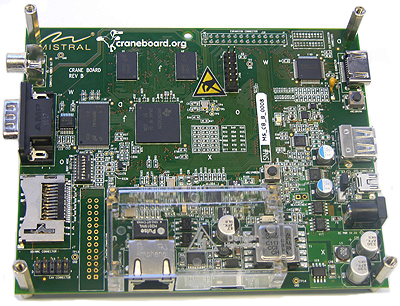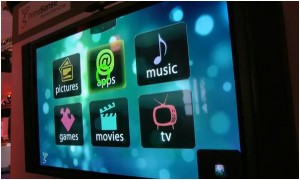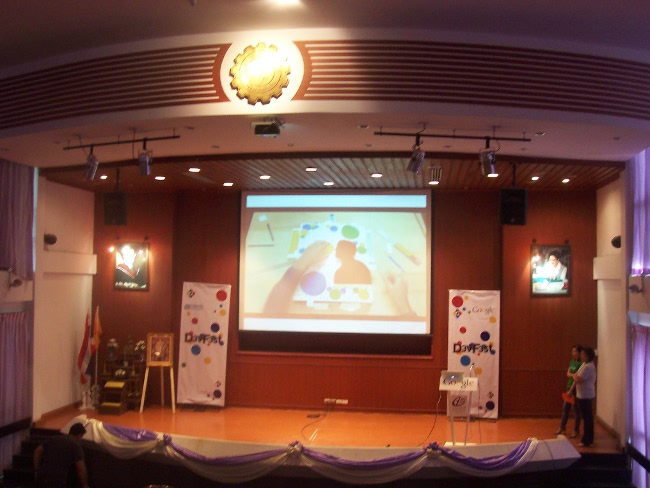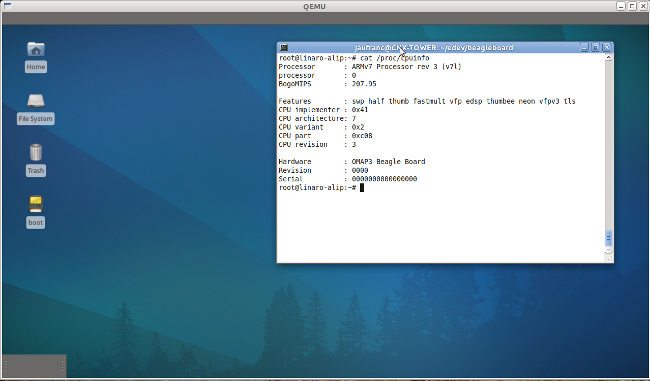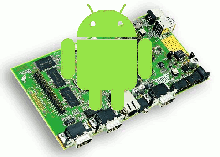CyanogenMod has announced that they would work with FreeXperia and support the following devices in the next release of CyanogenMod: Xperia Arc Xperia Neo Xperia Mini Xperia Mini Pro Xperia Play Xperia Ray Xperia X10 Xperia X8 Xperia X10 Mini Xperia X10 Mini Pro Cyanogen (Steve Kondik) also mentionned that FreeXperia is now part of CyanogenMod development team. Back in January, I’d already posted that it was possible to install a hacked version of Android 2.2 on Xperia X10. You can follow Xperia X10 Development on CM7.1 on XDA form and obtain the source code on github. ROMs based on CyanogenMod 7 for Xperia X8 and Xperia X10 Mini are available at http://code.google.com/p/minicm/ Jean-Luc Aufranc (CNXSoft)Jean-Luc started CNX Software in 2010 as a part-time endeavor, before quitting his job as a software engineering manager, and starting to write daily news, and reviews full time later in 2011. www.cnx-software.com
Qualcomm APQ8060 Android Development Board BSQUARE DragonBoard
BSQUARE announced the DragonBoard a development board built around Qualcomm APQ8060 mainly targeted at Android 2.3 development. Here’s an excerpt of the press release: BSQUARE Corporation, a leading enabler of smart, connected devices, today announced general availability of DragonBoard™, an Android™ development platform based on Qualcomm Incorporated’s Snapdragon™ APQ8060 processor. DragonBoard provides device makers, application developers and other hardware and software ecosystem suppliers with early access to the APQ8060 processor in a flexible development environment. DragonBoard is a powerful, feature-rich development board that offers exposed connectors, adapters and expansion headers including JTAG, Ethernet and mini USB. These features provide deep levels of development, testing and expansion that allow OEMs to do early prototyping of APQ8060 based systems, component suppliers to integrate devices with the APQ8060 processor and Android application developers to create innovative applications for the growing open source development community. When combined with BSQUARE products and services, DragonBoard enables […]
Redirect all output to a log file
When you build a program or execute a shell command, the messages are often outputted to both standard output and standard error. If you want to send all ‘printf’ to a log file, use the following command: make > make.log 2>&1 “2>&1” is the part that redirects standard error to standard out, allowing you to capture all messages. Jean-Luc Aufranc (CNXSoft)Jean-Luc started CNX Software in 2010 as a part-time endeavor, before quitting his job as a software engineering manager, and starting to write daily news, and reviews full time later in 2011. www.cnx-software.com
CraneBoard: Low Cost Development Board based on TI AM3517
The CraneBoard is a low-cost, open-source hardware development platform based on the AM3517 Sitara ARM Cortex-A8 microprocessor. The CraneBoard was announced in December 2010, can be purchased for 199 USD and can be an alternative to the Beagleboard-xM. AM3517 is especially suited to industrial applications and would be a preferable platform if your project needs CAN or PoE support. The board has less RAM (256 MB vs. 512MB) and no camera port. Here are the features and specifications of the board (I highlighted the differences with Beagleboard-xM in green): AM3517 Sitara ARM Cortex-A8 – 600MHz Integrated 3D Graphics Accelerator RAM: 256 MB NAND Flash: 256MB Support for on-chip peripherals: 10/100 EMAC USB OTG utilizing on-processor PHY 3.3V I/O CAN Bus DDR2 Power over Ethernet and other power options including USB and DC MMC/SD Card Support Fully open-source four-layer PCB Fully Open Source Linux Board Support package (2.6.32) Based on existing […]
New Remote Technologies to Control Smart TVs
With Internet-connected flat TVs and set-top boxes, we can now use browse the web and play games. But the traditional remote is not up to the task and new solutions are needed to interact with smart TVs and internet STB such as gesture recognition, wii-like remotes and tablet/smartphone control. A few companies showcased their solutions at IBC (International Broadcasting Convention) 2011, which took place between the 9th and 13th of September 2011 in Amsterdam: PrimeSense Gesture Recognition PrimeSense, an Israel-based company known for its range image sensor embedded in the “Kinect” motion-based controller for Xbox, began to promote the sales of its range image sensors to TV and STB makers. PrimeSense ran a prototyped UI software on a notebook PC and controlled the UI by using a gesture recognition device connected to a PC. The UI can be operated by moving a hand. You can then control TV screen like […]
Summary of Google Devfest 2011 Chiang Mai, Thailand
I attended Google Devfest 2011 in Chiang Mai, Thailand last Saturday (24 September 2011) . This was really interesting and enlightening. So if are a developer, I really recommend to register to a Devfest if Google comes to your city. I was relatively surprised by the number of attendees which I estimate between 150 to 200. This Devfest focused on three main subjects: Android HTML5 (and Chrome) Google Analytics Please find the complete schedule below: Track 1 Track 2 09:00 – 09:30 Keynote 09:30 – 10:30 Android Market for Developers (Ankur Kotwal) 10:30 – 11:00 AM Break 11:00 – 12:00 Bleeding Edge HTML5 (Eric Bidelman) 12:00 – 13:00 Implementing Google Analytics (Vinoaj Vijeyakumaar) 13:00 – 14:00 Lunch 14:00 – 15:00 What’s New and Important in Android (Ankur Kotwal) Displaying Large Geographic Datasets: Google Fusion Tables (Luke Mahe) 15:00 – 16:00 These Aren’t the Site You’re Looking For: Modern HTML5 Web Apps (Eric Bidelman) Working Off the Grid: HTML5 Offline (Ernest Delgado) 16:00 – 16:30 PM Break 16:30 – 17:30 Insights […]
Beagleboard Emulator in Ubuntu with Qemu
If you just want to try a program on Beagleboard, but do not want (or have the means) to purchase a board, you may be able to use qemu to emulate the Beagleboard or BeableBoard-xM. I’ll details the instructions to run the Nano build (minimal kernel) and the ARM Linux Internet Platform (ALIP) distribution for Beagleboard on qemu. Please read the full post before starting the installation before there are currently some issues such as no Ethernet support. First, install or update linaro-media-create: sudo add-apt-repository ppa:linaro-maintainers/tools sudo apt-get update sudo apt-get install linaro-image-tools Then download the nano image and omap3 hardware pack: wget http://releases.linaro.org/platform/linaro-n/nano/11.08/nano-n-tar-20110823-1.tar.gz wget http://releases.linaro.org/platform/linaro-n/nano/11.08/hwpack_linaro-omap3_20110823-0_armel_supported.tar.gz Generate the image for qemu: sudo linaro-media-create –image_file beagle_sd.img –dev beagle –binary nano-n-tar-20110823-1.tar.gz –hwpack hwpack_linaro-omap3_20110823-0_armel_supported.tar.gz If you don’t have it already, get the latest qemu-linaro package from Linaro Maintainers PPA: sudo apt-get install qemu-system Check the version is correct: qemu-system-arm -version QEMU emulator version […]
How to Develop and Port Android to a New Hardware Platform with Linaro
Zach Pfeffer, Linaro Android Working Group tech lead, gives an introduction to making Android work on a new hardware platform at Linaro Connect Q3.11 in Cambridge, August 2011. He starts by giving details about Android, its implementation, and how source code is managed. He then gives details about how to add support for a new board, taking advantage of Linaro scripts and infrastructure, already supporting community boards from several ARM SoC vendors. Here are the main topics covered during this 48 minutes presentation: General Android Overview (at 5:00 in the video) and different Android “components”: The Linux kernel Non-upstreamed kernel extensions A set of shared and static libraries A set of Hardware Abstraction Layers (HALs) A JIT capable VM Android activity framework Android applications Repo, Gerrit and Git (25:50) Porting to a new Platform (35:07) HALs and Hardware Acceleration (39:00) Continuous Integration (41:02) Linaro Evaluation Build (LEB) Integration (45:06) Slides […]



